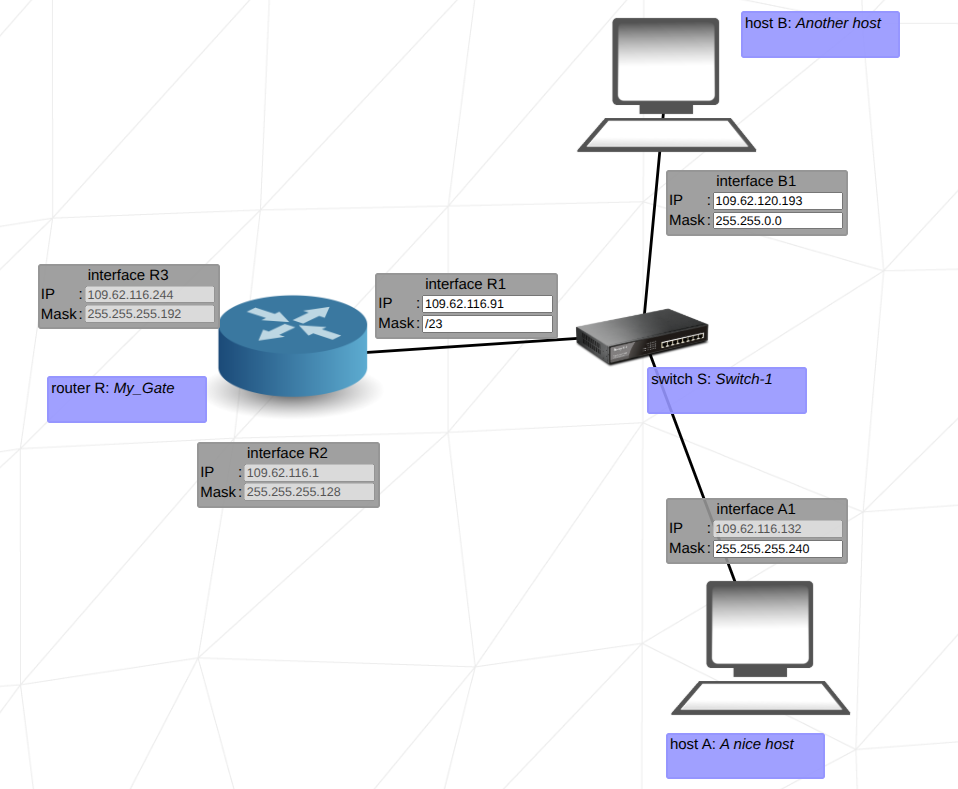The goal of this project was to familiarize ourselves with IP addressing within the TCP/IP model. We had to configure the IP adresses and network masks of 10 simulated networks with routers, switches, a internet gateway and computers.

It's a framework of protocols that ensures the transmission of data across networks (including the internet). The communication protocols are organized in 4 layers of different purpose: Application, Transport, Internet, and Network Access.
Application Layer
Consists of different protocols that are necessary to communicate between applications across a network:
- Web: Browser ↔ Webserver (
HTTP,HTTPS) - Email: Mail client ↔ Mail server (
SMTP,IMAP,POP3) - File transfer: Client ↔ Server (
FTP,SFTP) - Remote connection: Admin ↔ Server (
SSH)
Transport layer:
Protocols that ensures delivery of data packets between applications on different devices: Most common are TCP or UDP. TCP is more reliable because it ensures the delivery of data packets. On the other side UPD (User Datagram protocol) is faster but doesn't garantee the arrival in the rigth order. The use cases for UDP: Streaming (video/audio), online gaming, VoIP, DNS.
Internet layer:
In a network the internet protocol IP asigns each device a unique logical address (IP address). In order to send data to the destination a router builds bridges between networks and routs the data to the destination. The core functionality of this layer is to pick a route and deliver the packet with IPv4 or IPv6.
IP :
ARP :
ICMP
Network access layer:
physical transmission (Wi-fi, ethernet)
You watching a video on a website.
Application layer: HTTPS
Transport layer: UDP
The Transmission Control Protocol (TCP) is set of rules that governs how computers communicate reliably over a network. Therefore it breaks data into small packets, sends them over the network and ensures they are delivered error free and in the correct order at the recipient.
The Internet protocoll (IP) is a protocoll and used for routing and addressing across networks. In IPv4 an address is a 32-bit long number and is divided into 4 octets (8-bit-segments).
"number1.number2.number3.number4" or "XXXXXXXX.XXXXXXXX.XXXXXXXXX.XXXXXXXXX"
198.98.23.23 or 11000110.1100010.00010111.00010111
An IP address has a network and a host part.
all number in the range 0-256
For example:
| Class | IP Range |
|---|---|
| class A | 10.0.0.0 - 10.255.255.255 |
| class B | 172.16.0.0 - 172.31.255.255 |
| class C | 192.168.0.0 - 192.168.255.255 |
local ip for internal use: 127.0.0.1 127.255.255.254
Broadcast address is the address that sends to every host of a network a message.
The network address is an unique identifier which will be assigned to each device in a network.
The subnetmask is a 32 bit long number and useful to calculate the ip range .
What is subnetting? Subnetting describes the division of network into smaller subnetworks. Depeding of bits in the netmask you can devide the network into smaller networks. What is a router?
What is a switch? A switch is device that forwards data to a mcadresses in a network. What is IP forwarding?